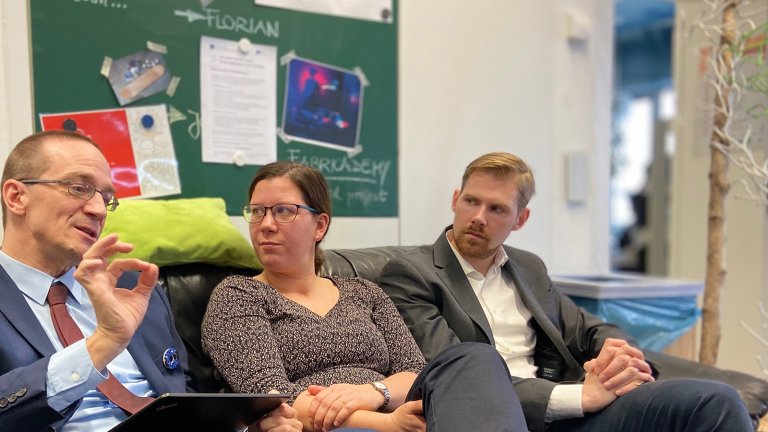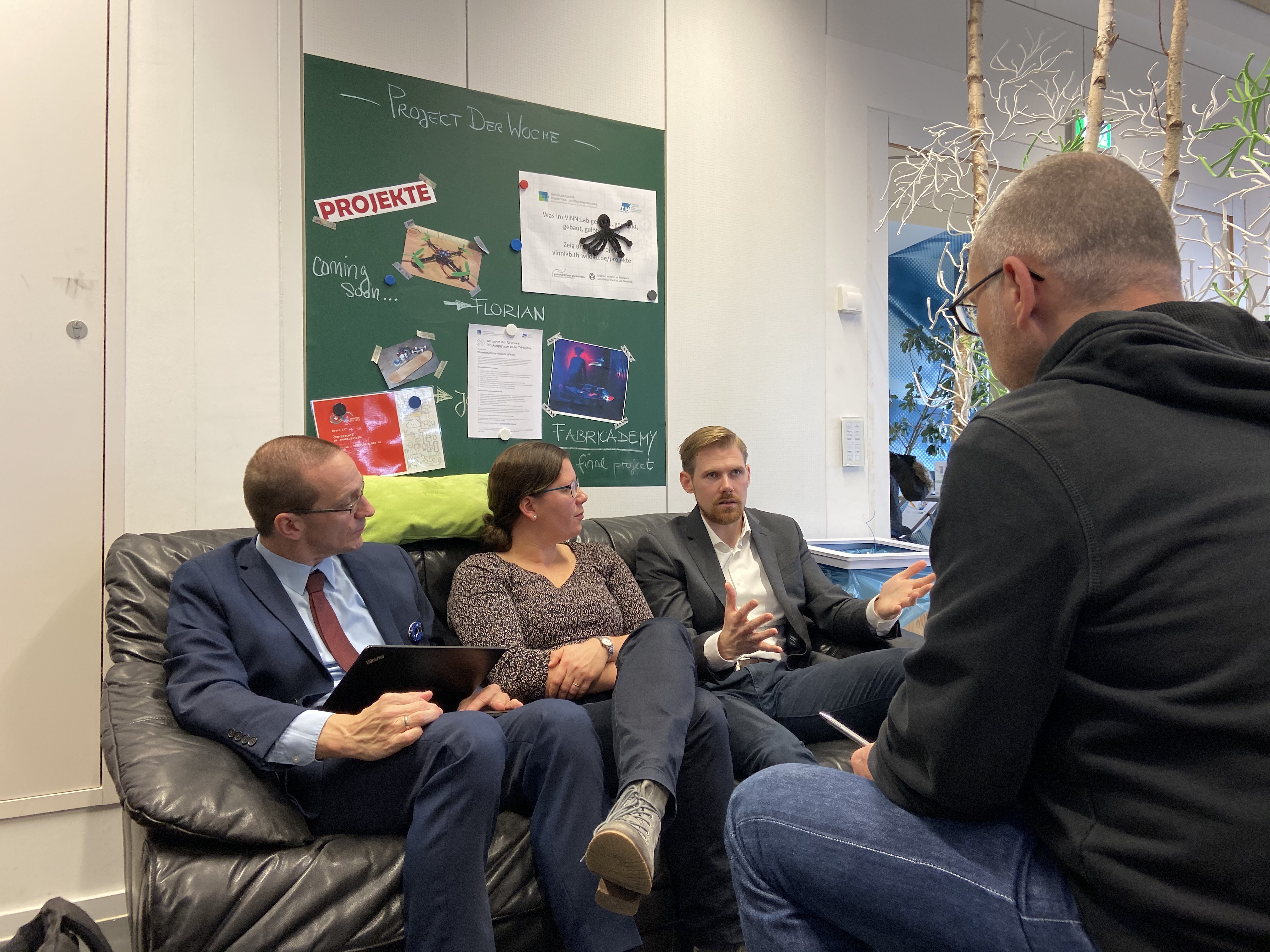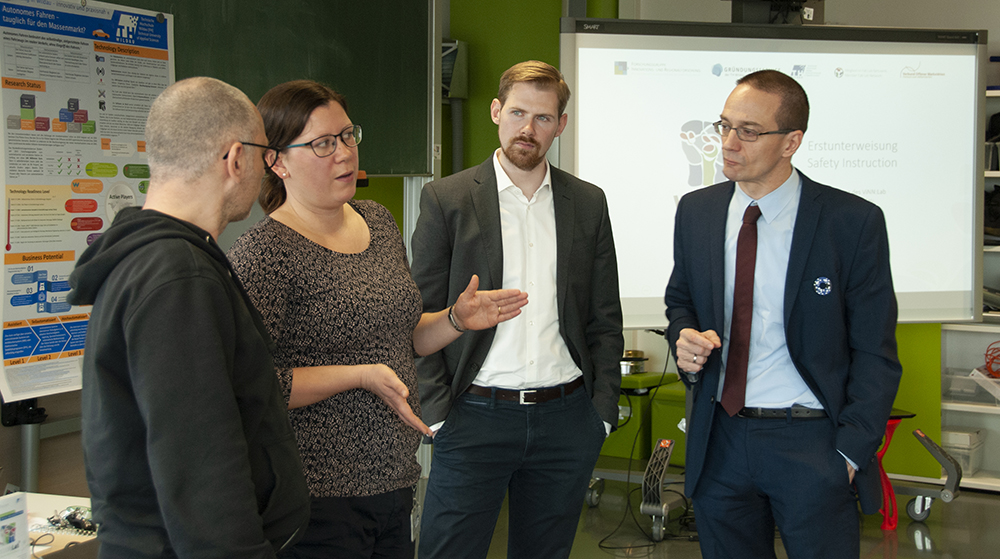
Transfer scouts for lightweight design — an interview
In an interview with the transfer scouts for lightweight design from Innovation Hub 13, the experts explain how university expertise is combined with company needs and the advantages of cooperation between companies and research.
“Combining university expertise with company needs”
Weight reduction, safety, standardisation: Five research institutes and companies from the Capital Region Berlin-Brandenburg have come together to build a device container that is unique worldwide. New joining techniques and the extremely light hybrid laminates play an important role here. They can more or less do everything that conventional materials cannot. Knowledge, experience and innovative spirit come together for the project.
Lightweight design offers many companies a good opportunity to make their presence known on the market. That said, many companies are not yet aware of the solutions that already exist or which process is best for a specific issue. This is why Stefan Kamlage from the PYCO research area at the Fraunhofer Institute for Applied Polymer Research IAP , Sarah Schneider from the Wildau Technical University of Applied Sciencesand Marco Lubosch from the Brandenburg University of Technology (BTU) Cottbus – Senftenberg help companies in Brandenburg in their search for the right solution.
So for what companies and products is lightweight design suitable?
Sarah Schneider: The best-known example is the transport sector, including astronautics, the automotive industry, railway vehicles and aircraft. This is because in all these cases it is important to reduce the overall weight with lighter components and thus also save operational costs and reduce emissions.
Stefan Kamlage: The process and lightweight design components are usually established in the aerospace sector first. This is because there are big possibilities to quickly save money in these areas with lighter parts, even when the difference in price to the conventional part is large. In the railway or automotive sector, lightweight design parts made of plastics in particular should usually cost only a few cents more than the parts used previously, otherwise they will not be introduced. Here the focus is especially on the fibre-reinforced components that are developed at the PYCO and the specialist department of Polymer-based Lightweight Design chaired by Professor Seidlitz at the BTU. lightweight design can be decisive for new technologies, such as in the field of electromobility. If individual components are lighter, the entire surroundings of these components are also lighter since the requirements on necessary load bearing capability are reduced. This in turn balances out the heavier weight of energy storage, for example in the electric car.
Marco Lubosch: It’s not just about moving parts. The frame of a machine is also a classic lightweight design part. There it’s a question of saving on raw materials. If a component can become 30 percent lighter this always means that 30 percent less material is needed.
Stefan Kamlage: On top of that, a lighter machine can be used more flexibly. The use of fibre-reinforced polymers and hybrid components offer particular potential. A load-bearing foundation that can spread the weight of a machine may no longer be needed. Instead the machine can be set up on an existing ceiling on the second floor of a production company without having to increase the residual load capacity.

Does lightweight design increase companies’ flexibility when it comes to suppliers?
Marco Lubosch: Of course. In this way lightweight design technologies such as additive manufacturing make things like the availability of replacement parts for the rail sector, for example, easier. This is because there are many different train types on the tracks, some new and some already over 50 years old. The train operators must, however, have replacement parts on hand at any given time for each model, and this requires huge warehouse capacity. However, if production using 3D printers could be established in every individual maintenance workshop, replacement parts could be produced at short notice and only the raw material from which the products are produced would have to be available.
Stefan Kamlage: This is also true for big companies where the production facilities often run for decades. If a component is faulty there, it will become more expensive the longer the facility is in operation. This is why replacement parts have to be available on site. In this respect, additive manufacturing has the advantage that the company can flexibly produce the replacement part on site, which means it is immediately available. More developed parts can be used to optimise the plants in this way too. Then production is likewise extremely flexible. University experts from the fields of simulation and dimensioning of (plastic) components can help here.
Where do companies find out about existing possibilities and which possibility is suited to them?
Sarah Schneider: That is our job, as transfer scouts. We primarily meet companies when they attend events or trade fairs. First, we see what needs the company has and we suggest certain solutions that have been developed by universities and research institutes, and put them into contact with each other. But it can also happen that companies come to us with a specific problem and ask if we know of a suitable solution in the area of lightweight design. If needed, we find the right experts at the universities and research institutes with the suitable solution. In doing so we try to combine the university’s expertise with the needs of the company.
Marco Lubosch: In August 2019 we held the first Day of Additive Manufacturing in Cottbus. Many companies initially only took part out of interest, without having any specific needs or project ideas. At the event they saw the production plants and were surprised at the possibilities that already exist in Brandenburg, possibilities they had until then known nothing about. These sorts of events breed ideas as to what companies will be able to do with these innovative technologies in the future in order to solve their own challenges. We were able to show companies that there are already solutions for a lot of things in Brandenburg and that the contact partners are right here too. They just have to grasp the opportunity.
Stefan Kamlage: We are also in close contact with the economic development agencies in Brandenburg and Berlin, the Association of German Engineers (VDI) with its working groups for plastic technology in Berlin and lightweight design technologies in Cottbus, founded by Professor Seidlitz, as well as regional economic development agencies or networks whose task it is to bring companies into contact with one another. A company in these networks speaks up when they have a problem they are unable to find a solution to. The networks then give us the contact details of the company. We can support the company along the entire value chain. This starts with material selection and development, covers simulation, dimensioning and construction, the production processes of semi-finished products and components, and goes all the way to manufacturing demonstrators. In addition to industry-standard processes, possible manufacturing processes range from hand-laminating and automated fibre placement system (AFP) to additive manufacturing. The design can now be done to meet requirements and no longer has to be production-oriented. Metals can often be replaced with polymers or fibre-reinforced plastics.
There are already transfer centres at universities that are busy with implementing research results via companies. What are your other possibilities as transfer scouts?
Stefan Kamlage: The transfer centres are in charge of conveying research results from all institutes of a university or a research area to the economy. They are not staffed enough to be able to delve into every single subject. As transfer scouts, we have a closer relationship with the topic and know exactly what we have to ask to find out what the companies need. This is how we are able to support the company better.
Marco Lubosch: We also have the advantage that we can connect the lightweight design expertise of all three universities and research institutes which are part of Innovation Hub 13. They complement each other very well and overlap thematically in only a few places. If I, for example, get an enquiry for which the BTU Cottbus-Senftenberg cannot provide an answer, we forward the enquiry of course to other partners in the Innovation Hub.
Sarah Schneider: We have close contact to the companies. We establish their needs and know what solutions already exist or what research group is currently working on one. The companies also find out what processes they can use in future. The opposite applies as well. By establishing the need from industry, we can indicate to research what problems exist for companies and at which points research is still needed.

What is the extent of your intermediary role between research and industry?
Sarah Schneider: It covers the presentation of available solutions, brokering contacts between research and companies, making specific appointments and ensuring that they actually take place, and even includes the role of a translator. Science and business often speak different languages. We can also provide support when it comes to funding applications for a specific development project that an industry and research partner want to tackle together.
Stefan Kamlage: We are also able to bring different companies together as potential partners. We regularly run workshops with the VDI working groups (plastic technology in Berlin, and plastics and lightweight design technologies in Cottbus). The latest topics are presented and companies exchange ideas. They can discuss new cooperation approaches in a calmer atmosphere. There are few companies in Brandenburg in the field of lightweight design that are competing commercially. Most of them complement each other because they work in different areas. Even if they are active in the same context they can network at the events and talk about problems they have already solved. There are few companies with enough resources to make all the mistakes themselves.
What should a company bear in mind when working with a university research team?
Sarah Schneider: It is important to remember that universities work according to other time cycles and do not always have enough staff to carry out a research and development project. Companies often have a completely different time management style in mind for these sorts of projects.
Marco Lubosch: We cannot, for instance, replicate series production at universities. If the universities and institutes are integrated, such a project is clearly of a research nature. In these cases, the point is to verify whether the products and processes are indeed as realisable as the company needs them to be.
What are the advantages of companies working with research?
Marco Lubosch: In our region we mainly have small and medium-sized companies. Usually they do not have their own research departments. On top of that, using new technologies can sometimes mean a big financial risk if it is still unclear whether investments will pay off later. This is why they are cautious and do not adopt new technologies as fast as they could. But many are not aware that research and development can and even should be outsourced in some measure to our institutes. There are specific funding means for this, from both the state and the Federal Government, that is intended to support the cooperation between public research institutes and companies.
The interview was conducted by Sven Ullrich for the campaign “Brandenburg – Sustainable Today” at the ViNN:Labb of the Wildau Technical University of Applied Sciences.
Transfer scouts for lightweight design
Dr.-Ing. Sarah Schneider
Transfer scout for lightweight design / Innovation Hub 13
Wildau Technical University of Applied Sciences
Tel.: +49 (0) 3375 508 498
Mobile: +49 (0) 175 1957644
Mail: sarah.schneider@th-wildau.de
Marco Lubosch, M.Sc.
Transfer scout for lightweight design / Innovation Hub 13
Brandenburg University of Technology Cottbus-Senftenberg
Tel.: +49 355 69 4464
Mobile: +49 170 282 63 89
Mail: Marco.Lubosch@b-tu.de
Dr. rer. Nat. Stefan Kamlage
Transfer scout for lightweight design / Innovation Hub 13
Fraunhofer Institute for Applied Polymer Research IAP
Tel.: 03328 330 299
Mail: stefan.kamlage@iap.fraunhofer.de